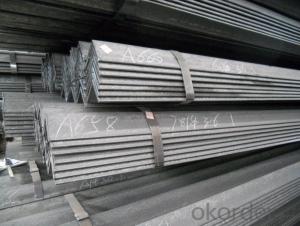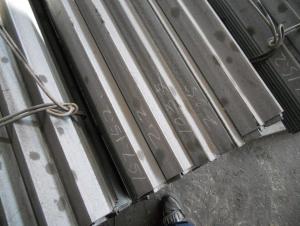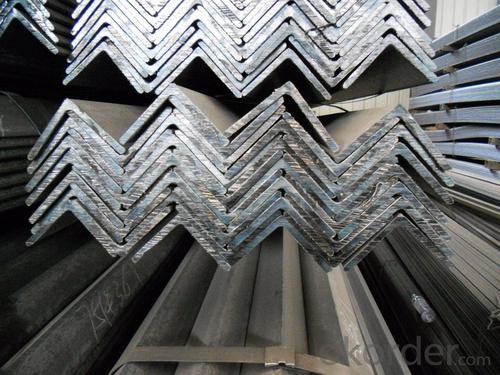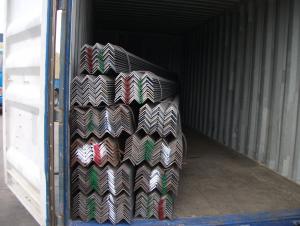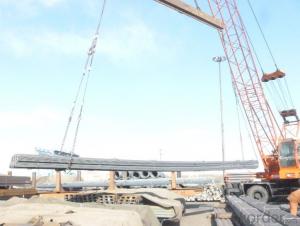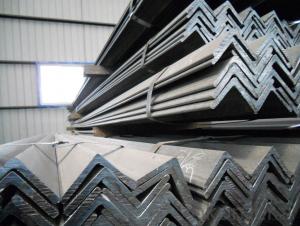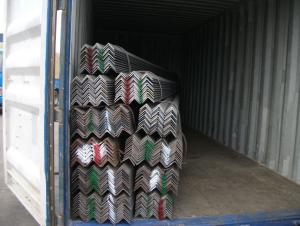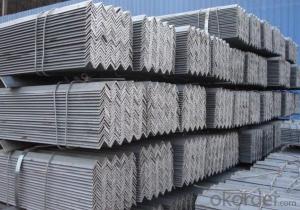Hot Rolled Equal Angle Steel with High Quality
- Loading Port:
- Tianjin
- Payment Terms:
- TT OR LC
- Min Order Qty:
- 20 m.t.
- Supply Capability:
- 1000 m.t./month
OKorder Service Pledge
OKorder Financial Service
You Might Also Like
Product Description:
OKorder is offering Hot Rolled Carbon Steel Equal Angle at great prices with worldwide shipping. Our supplier is a world-class manufacturer of steel, with our products utilized the world over. OKorder annually supplies products to European, North American and Asian markets. We provide quotations within 24 hours of receiving an inquiry and guarantee competitive prices.
Product Applications:
According to the needs of different structures, Angle can compose to different force support component, and also can be the connections between components. It is widely used in various building structures and engineering structures such as roof beams, bridges, transmission towers, hoisting machinery and transport machinery, ships, industrial furnaces, reaction tower, container frame and warehouse etc.
Product Advantages:
OKorder's Equal Angle are durable, strong, and resist corrosion.
Main Product Features:
· Premium quality
· Prompt delivery & seaworthy packing (30 days after receiving deposit)
· Corrosion resistance
· Can be recycled and reused
· Mill test certification
· Professional Service
· Competitive pricing
Product Specifications:
1. Invoicing on theoretical weight or actual weight as customer request
2. Length: 6m, 9m, 12m as following table
3. Sizes
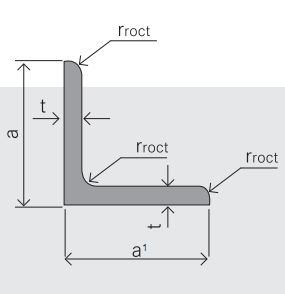
Sizes: 25mm-250mm | ||
a*t | ||
25*2.5-4.0 | 70*6.0-9.0 | 130*9.0-15 |
30*2.5-6.6 | 75*6.0-9.0 | 140*10-14 |
36*3.0-5.0 | 80*5.0-10 | 150*10-20 |
38*2.3-6.0 | 90*7.0-10 | 160*10-16 |
40*3.0-5.0 | 100*6.0-12 | 175*12-15 |
45*4.0-6.0 | 110*8.0-10 | 180*12-18 |
50*4.0-6.0 | 120*6.0-15 | 200*14-25 |
60*4.0-8.0 | 125*8.0-14 | 250*25 |
Packaging & Delivery of Angle Steel
1. Packing: it is nude packed in bundles by steel wire rod
2. Bundle weight: not more than 3.5MT for bulk vessel; less than 3 MT for container load
3. Marks:
Color marking: There will be color marking on both end of the bundle for the cargo delivered by bulk vessel. That makes it easily to distinguish at the destination port.
Tag mark: there will be tag mark tied up on the bundles. The information usually including supplier logo and name, product name, made in China, shipping marks and other information request by the customer.
If loading by container the marking is not needed, but we will prepare it as customer request.
Production flow of Angle Steel
Material prepare (billet) —heat up—rough rolling—precision rolling—cooling—packing—storage and transportation
FAQ:
Q1: Why buy Materials & Equipment from OKorder.com?
A1: All products offered byOKorder.com are carefully selected from China's most reliable manufacturing enterprises. Through its ISO certifications, OKorder.com adheres to the highest standards and a commitment to supply chain safety and customer satisfaction.
Q2: How do we guarantee the quality of our products?
A2: We have established an advanced quality management system which conducts strict quality tests at every step, from raw materials to the final product. At the same time, we provide extensive follow-up service assurances as required.
Q3: How soon can we receive the product after purchase?
A3: Within three days of placing an order, we will begin production. The specific shipping date is dependent upon international and government factors, but is typically 7 to 10 workdays.

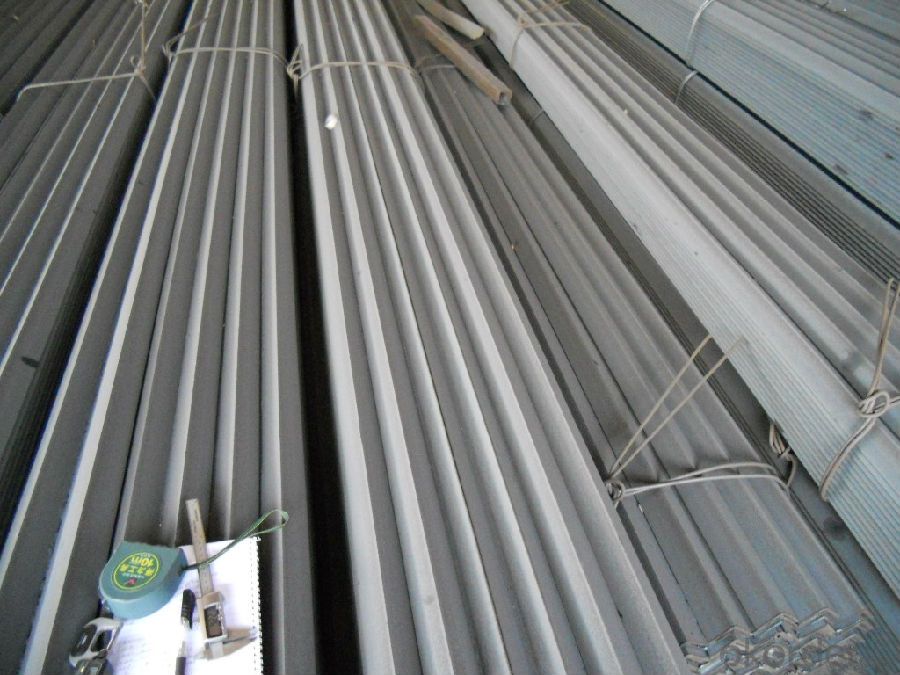
- Q: What is the weight-bearing capacity of steel angles?
- The weight-bearing capacity of steel angles is determined by a range of factors, including the angle's dimensions, thickness, the type of steel employed, and the specific load it bears. Due to their strength and load-bearing capabilities, steel angles find widespread use in construction and structural applications. Nevertheless, it is crucial to refer to engineering tables or seek guidance from a structural engineer to ascertain the precise weight-bearing capacity of a steel angle in a given scenario.
- Q: What are the considerations for selecting the appropriate steel angle connection type?
- To ensure the structural integrity and stability of the connection, it is crucial to take several considerations into account when selecting the appropriate steel angle connection type. Firstly, the connection type should have the capacity to withstand anticipated loads, including dead load, live load, wind load, and seismic load. It should efficiently transfer these loads without causing any failure or compromise in the overall structure. Secondly, the connection type should meet the specific structural requirements of the project, such as the desired level of stiffness, flexibility, or rigidity. This includes considering factors like the connection's ability to resist deflection or movement under different loading conditions. Moreover, safety and reliability should be prioritized when choosing the connection type. It should provide a secure and durable connection that will not fail or deteriorate over time. Factors such as material properties, corrosion resistance, and maintenance requirements should be taken into consideration to ensure long-term performance. Cost-effectiveness is also important. The selected connection type should balance material and labor requirements while meeting necessary performance standards. Factors like ease of fabrication, installation, and maintenance can help determine the most cost-effective option. Compatibility and availability are other crucial factors. The connection type should be compatible with existing steel members and readily available in the market to avoid delays or supply chain issues during construction. Additionally, any specific design or construction constraints, such as space limitations or access restrictions, should be considered. The connection type should accommodate these constraints without compromising the overall structural integrity. Lastly, it is essential to ensure that the selected connection type complies with applicable building codes, standards, and regulations. This guarantees the safety and legal compliance of the structure. By carefully considering these factors, engineers and designers can choose the appropriate steel angle connection type that best meets the project's requirements in terms of load capacity, structural integrity, safety, cost-effectiveness, and compliance with codes and regulations.
- Q: Can steel angles be used in the construction of government buildings?
- Yes, steel angles can be used in the construction of government buildings. Steel angles are commonly used as structural components in building construction due to their strength and durability. They provide stability and support to the overall structure, making them suitable for use in government buildings, which often require robust and long-lasting construction materials. Additionally, steel angles can be easily fabricated and customized to meet specific design requirements, making them a versatile choice for various architectural and structural applications in government buildings.
- Q: What is the difference between equal and unequal steel angles?
- Structural steel components commonly used in construction and industrial applications include equal and unequal steel angles. The dimensions and properties of these angles are what set them apart. Equal steel angles, also known as L-shaped angles, have sides and angles that are the same. They are frequently employed to provide support and stability in various structures like buildings, bridges, and machinery. The symmetrical load distribution and balanced strength in all directions make them perfect for applications requiring equal support on both sides. In contrast, unequal steel angles have sides and angles that differ. These angles are used when there is a need for uneven load distribution or a specific angle for a particular job. The longer side of the angle typically carries the load, while the shorter side can provide additional support or serve as a connection point. Unequal angles are commonly used in constructing frames, brackets, and supports where uneven load distribution is expected. Both equal and unequal steel angles are made from carbon steel, which offers good strength and durability. They can be either hot-rolled or cold-formed, depending on the manufacturing process. Hot-rolled angles are produced at high temperatures, resulting in a rough surface finish but improved mechanical properties. On the other hand, cold-formed angles are shaped and bent at room temperature, resulting in a smoother surface finish but slightly lower mechanical properties. In conclusion, the main distinction between equal and unequal steel angles lies in their dimensions and load distribution abilities. Equal angles have identical sides and are used for symmetrical load distribution, while unequal angles have different side lengths and are used for uneven load distribution or specific angle requirements. Both types of angles are made from carbon steel and find common usage in construction and industrial applications.
- Q: Are steel angles suitable for earthquake-resistant construction?
- Indeed, earthquake-resistant construction can make use of steel angles. Steel, known for its strength and ductility, is an ideal material for withstanding seismic forces. Specifically, steel angles are commonly employed in seismic design and construction because of their ability to offer structural stability. Bracing elements in buildings often consist of steel angles, which help withstand lateral forces resulting from earthquakes. These angles can be installed diagonally between structural members, creating a rigid frame capable of effectively absorbing and dissipating seismic energy. By distributing the forces generated during an earthquake, these angles play a crucial role in preventing structural collapse. Moreover, steel angles can be designed and fabricated to meet specific seismic design criteria. Engineers can consider factors such as the building's location, expected seismic activity, and desired level of earthquake resistance. By utilizing advanced computer-aided design and analysis tools, engineers can optimize the placement and size of steel angles, thereby enhancing the structure's overall seismic performance. Apart from their strength and ductility, steel angles offer other advantages for earthquake-resistant construction. They are lightweight, reducing the overall weight of the structure and enabling more efficient seismic design. Additionally, steel is a recyclable material, making it a sustainable choice for construction projects. However, it is important to note that the suitability of steel angles for earthquake-resistant construction relies on various factors, including the specific design, construction techniques, and adherence to building codes and regulations. Professional engineering expertise and thorough analysis are essential to ensure the appropriate utilization of steel angles in seismic design. In conclusion, steel angles are suitable for earthquake-resistant construction due to their strength, ductility, and ability to provide structural stability. When appropriately designed and installed, they can effectively resist seismic forces and contribute to the overall safety and resilience of the structure.
- Q: How do you calculate the load distribution on a steel angle?
- In order to determine the load distribution on a steel angle, several factors must be taken into account, including the angle's geometry, properties, and the applied load. Follow these steps to calculate the load distribution: 1. Start by obtaining the dimensions and properties of the steel angle. Measure its length, width, and thickness, and determine important material properties like yield strength and modulus of elasticity. 2. Identify the location where the load is being applied on the steel angle. This could be a single point or distributed along the length of the angle. 3. Calculate the moment of inertia, which represents the angle's resistance to bending. This calculation depends on the angle's dimensions and shape. You can use standard formulas or consult appropriate tables for common steel angle shapes. 4. With the moment of inertia and the applied load determined, you can calculate the bending stress. Use the formula: bending stress = (M * c) / I, where M is the applied moment, c is the distance from the neutral axis to the extreme fiber, and I is the moment of inertia. 5. The load distribution on the steel angle is determined by the bending stress. Areas farther from the neutral axis experience higher stress, resulting in a non-uniform load distribution. Plotting the stress distribution along the angle will help visualize areas of higher and lower stress. 6. Finally, compare the calculated load distribution with the load capacity of the steel angle. The angle's load capacity is typically determined by the material's yield strength and a safety factor. It's crucial to ensure that the calculated load distribution does not exceed the load capacity, as this ensures the structural integrity of the angle. Please note that these calculations are simplified and assume ideal conditions. In practical applications, factors such as deformation, buckling, and support conditions may need to be considered. It is recommended to consult structural engineering resources or professionals for accurate results.
- Q: Are steel angles suitable for historical restoration projects?
- Yes, steel angles can be suitable for historical restoration projects. Steel angles are versatile and durable, making them an excellent choice for structural support and reinforcement in historic buildings. They can be used to restore or replicate original architectural features, such as window frames, ornamental railings, and decorative elements. Additionally, steel angles can be fabricated to match the original design and provide a seamless integration with the existing structure. However, it is important to consider the specific requirements and regulations of the historical restoration project, as some preservation authorities may have restrictions on the use of modern materials. Consulting with experts in historical restoration and obtaining necessary approvals will ensure that steel angles are used appropriately and effectively in preserving the historical integrity of the building.
- Q: Can steel angles be used in electrical installations?
- Yes, steel angles can be used in electrical installations. They are often used as structural supports or brackets for mounting electrical equipment such as junction boxes, conduit systems, or cable trays. Steel angles provide strength and stability to secure and organize electrical components effectively.
- Q: What are the alternatives to steel angles in construction?
- Construction offers various alternatives to steel angles, each with its own advantages and disadvantages depending on the specific application. 1. Aluminum angles provide a lightweight and corrosion-resistant option for outdoor construction projects. They are easily machinable and have good electrical conductivity. However, they may not possess the same strength and load-bearing capacity as steel angles, limiting their suitability for heavy-duty structural applications. 2. Fiberglass angles, on the other hand, offer a lightweight and non-conductive solution that is highly resistant to corrosion and chemical damage. They are commonly used in industries exposed to harsh environments. However, their strength may be inferior to that of steel angles, necessitating additional reinforcement for heavy loads. 3. Carbon fiber angles are known for their lightweight and high-strength properties, making them ideal for weight reduction in critical applications like aerospace and automotive industries. However, they tend to be more expensive than steel angles and require specialized manufacturing techniques. 4. Wood angles, made from hardwood or engineered wood products, present a traditional and cost-effective alternative to steel angles. They are readily available and easy to work with, often used in residential and light commercial construction projects. However, their strength and durability may not match that of steel angles, and they may be prone to warping, cracking, or rotting over time. When selecting an alternative to steel angles, it is crucial to consider the specific requirements of the construction project, including load-bearing capacity, environmental conditions, and budget. Consulting with a structural engineer or construction professional can help determine the most suitable option for each scenario.
- Q: What is the maximum length for a steel angle bracket?
- The maximum length for a steel angle bracket can vary depending on the manufacturer and the specific design of the bracket. However, in general, steel angle brackets are commonly available in lengths ranging from 1 inch to 8 feet or more. It's important to note that longer brackets may be more prone to bending or flexing under heavy loads, so it's essential to consider the intended application and weight-bearing requirements when selecting the appropriate length for a steel angle bracket. Additionally, consulting the manufacturer's guidelines and specifications is recommended to ensure the bracket's maximum length is not exceeded, as this could compromise its structural integrity.
Send your message to us
Hot Rolled Equal Angle Steel with High Quality
- Loading Port:
- Tianjin
- Payment Terms:
- TT OR LC
- Min Order Qty:
- 20 m.t.
- Supply Capability:
- 1000 m.t./month
OKorder Service Pledge
OKorder Financial Service
Similar products
Hot products
Hot Searches

